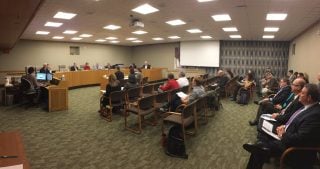
(Photo: Oregon Walks)
A bill that would establish an official State of Oregon Vision Zero Task Force got its first public hearing today. And it was heart-wrenching.
The eight members of the House Committee On Transportation Policy who presided over the hearing for House Bill 2667 probably didn’t expect the 8:00 am start time to attract testimony from nearly two-dozen people. And they probably didn’t expect to hear from people like Marina Hajek, the mother of a 10-year old boy who was hit and killed by a reckless, speeding driver while walking his bike across a street in Eugene 10 years ago.
“How many more deaths will it take? How many more memorials? How many more children have to die?”
— Marina Hajek, Eugene resident
As she spoke this morning, Hajek apologized for breaking into tears — something she still does when thinking of her son. “It’s just that I have been in front of so many committees and I always think, ‘Is this going to be the one that’s going to be brave enough to finally confront the reality of our streets?'” she said, sobbing. “How many more deaths will it take? How many more memorials? How many more children have to die? How many more brothers and uncles?”
Hajek put a human face on a bill that comes up as Oregon lawmakers, bureaucrats, and advocates try to respond to a significant uptick in fatalities in the last two years. The issue is also personal for House Representative Rob Nosse, the chief sponsor of the bill. He opened this morning’s testimony by recounting his memory of Portland teenager Fallon Smart, who died while trying to walk across a street just three blocks from his house. “It could easily have been one of my teenage children,” he told fellow legislators.
And five members of Oregon and SW Washington Families for Safe Streets testified today. After sharing their stories, they left a copy of this with each legislator…
Nosse and a coalition of supporters led by The Street Trust (formerly the Bicycle Transportation Alliance) see HB 2677 as a key starting point to change the culture of safety at the state level. The Street Trust Policy Director Gerik Kranksy explained the need for the bill by saying a new approach is necessary. “Vision Zero focuses on preventing injuries. The vulnerabilities of the human body, not the collision itself, should drive the design of our transportation system,” he testified. With 492 deaths on Oregon roads last year, Kransky added that, “What we’re doing currently isn’t enough. Vision Zero calls on us to do more.”
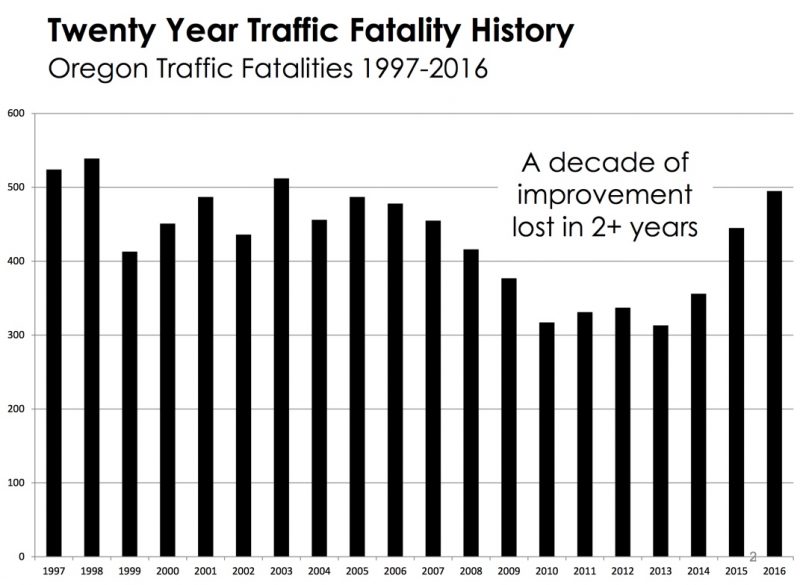
HB 2667 is supported by an impressive list of key interest groups including AARP Oregon, Oregon Walks, Springfield Public Schools, the League of Oregon Cities, the Association of Oregon Counties, the Oregon Environmental Council, Transportation for America, and many independent citizens — especially those who have lost loved ones like Ms. Hajek.
In a surprising development, the Transportation Development Division administrator for the Oregon Department of Transportation, Jerri Bohard, offered testimony that seemed to undercut HB 2667. She said the bill focuses only on people who walk and use bicycles. And, “While they are certainly vulnerable users of the system,” Bohard said, “a safety plan must consider and encompass all users.” (*Note: The text of the bill states, “The task force shall examine strategies to reduce and eliminate traffic crashes, particularly serious injury and fatal crashes and those involving bicycles and pedestrians.)
Advertisement

In addition to her claim that the bill doesn’t focus on all road users, Bohard also put on the record that ODOT feels the work of a new Vision Zero Task Force could duplicate work recently completed through ODOT’s 2016 Transportation Safety Action Plan. “The work of the task force,” Bohard continued, “could also result in different safety investment priorities than those identified in the Oregon Transportation Safety Action Plan, since it does not consider all users of the system.”
Bohard’s concerns were echoed by other people who testified in support of the Vision Zero bill, most of whom said the two should not be seen as mutually exclusive and that perhaps there would be a way to merge the efforts.
“We’re underrepresented in trips and overrepresented in deaths.”
— Gerik Kransky, The Street Trust
Asked about Bohard’s testimony, Kransky with The Street Trust said he’s already met with the ODOT administrator and is aware of the concerns. “It was pretty clear they [ODOT] feel the Transportation Safety Action Plan is the primary and only vehicle for making these kind of policy recommendations.” But Kransky sees the push for Vision Zero as vital on several levels. He thinks its approach will be broader in scope and could build more political support for the state’s traffic safety goals. “That’s where I hope we end up,” he said. For Kransky, the biggest “game-changer” of the Vision Zero approach (compared to ODOT’s approach) is “bringing fresh eyes and the public health perspective to the table.” By having a representative from the Oregon Health Authority (as HB 2667 mandates), Kranksy says the new task force, “Could bring an epidemiological perspective to the human health crisis that exists.”
As for Bohard’s assertion that HB 2667 focuses too narrowly on just bikers and walkers, Kranksy said she’s technically correct. The bill does specifically emphasize vulnerable road users, and that’s the point. “If on average, 6.6 percent of Oregonians walk and bike to work, yet they represent 20 percent of serious injuries and fatalities — that disparity is alarming and call for some focus in our work. We’re underrepresented in trips and overrepresented in deaths.” (According to the latest ODOT statistics, 80 people died while biking or walking in 2016 (10 and 70 respectively) – or about 16 percent of the 495 total deaths.)
Today’s hearing ended without a vote. It appears there will be more discussions and possibly amendments before it comes back for a second hearing. If it passes out of this committee it will also have to pass out of the Ways and Means Committee because there will be funding required to set up the task force (just how much isn’t known at this point).
In the same hearing this morning, the committee members also had an informational presentation about traffic safety from ODOT Director Matt Garrett and Transportation Division Administrator Troy Costales. They focused solely on distracted driving and what Costales referred to as “belts, booze and speed” — the deadly combination of not wearing seatbelts, driving drunk, and driving too fast. The difference between ODOT’s usual approach to blaming deaths and injuries on human error runs directly counter to the tenets of Vision Zero which put the onus on road design and policy. It will be interesting to see how these two approaches meet — or don’t — in the coming weeks and months.
Marina Hajek, who became a member of the Vision Zero Task Force in Eugene after her son died, just wants the state to help. “We can’t do it alone. We need your support.”
— Jonathan Maus: (503) 706-8804, @jonathan_maus on Twitter and jonathan@bikeportland.org
BikePortland is supported by the community (that means you!). Please become a subscriber or make a donation today.



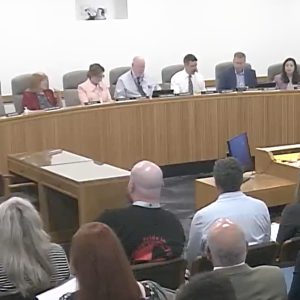

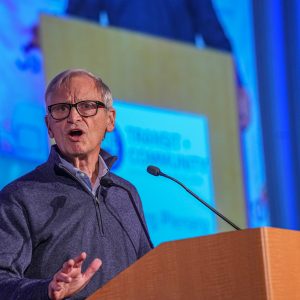
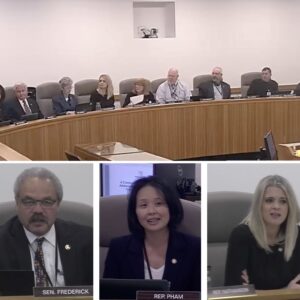
Thanks for reading.
BikePortland has served this community with independent community journalism since 2005. We rely on subscriptions from readers like you to survive. Your financial support is vital in keeping this valuable resource alive and well.
Please subscribe today to strengthen and expand our work.
Thanks for the reporting on this important topic.
Thanks for posting this. Of the 492 deaths last year, what was the breakdown of pedestrians, cyclists, car riders, & other?
2016 is not posted yet. Here are the 2015 quick facts:
http://www.oregon.gov/ODOT/TD/TDATA/car/docs/2015_QuickFacts.pdf
410 fatal crashes, 445 fatalities, 283 drivers, 81 passengers, 73 pedestrians, 8 cyclists and 60 of the total were motorcyclists.
Here’s the most current data via ODOT (not available publicly yet. I asked a secret source for it ;-).. Please note the numbers are still considered preliminary – which means full encoding of crash data not complete yet and numbers could change one or two here or there)..
So that’s 80 deaths while biking or walking… or about 16 percent of the total
That data is available here, though the 2016 numbers are not posted yet. https://www.oregon.gov/ODOT/TD/TDATA/pages/car/car_publications.aspx
How can the trend be stopped with so many road-widening projects from Salem to Hillsboro?
It won’t, without major changes at ODOT. Until their budget focuses more on safety improvement and less on roadway expansion, the deaths will continue.
“How can the trend be stopped with so many road-widening projects from Salem to Hillsboro?” rick
Possibly at least slowed down in part by provision of wider sidewalks and bike lanes, and reductions in speed limits to those much more complimentary to safety and livability objectives; example: 40mph speed limits down to 25 or even 20 mph.
I’m inclined to think that rather than the width of roads beyond that of two lane roads, it’s the high speed limits that roads are posted for, and the actual high speeds some people driving elect to travel at on those roads, that is the truer contributor to hazardous conditions on roads.
Bring the high speed limits down. Look at Hwy 26 or Hwy 217 in Beaverton: during rush hour when the traffic is creeping along at 15mph or less, conditions on those highways isn’t very dangerous at all to someone riding along on the emergency lane width shoulder that can substitute as a bike lane. At least not dangerous from the potential for collision….though the exhaust fumes are bad.
Thank you to all who testified. It may feel like you are shouting into the wind, but your voices are being heard.
Thinking of Brett Jarolimek today. Thanks to those who are working so hard in advocacy for us all.
After the Task Force there will be a steering committee that will have some off-site meetings, and publish a white paper. Follow by a resolution. A consultant might be hired.
Sorry, there’s no budget for a consultant. We’ll try to add that later.
This reminds me of Brent Toderian saying, “Don’t balance road users, prioritize people walking, biking and using transit”
http://denver.streetsblog.org/2017/02/09/brent-toderian-dont-balance-modes-prioritize-walking-biking-and-transit/
Is “pedalcyclist” ODOT-speak for “bicyclist?
If so, JM, bicylist deaths are but 2% of the total.
By that measure we would be doing better than all other categories, and a 25% increase year-over-year (8 to 10) would be statistically insignificant.
I’ll say it again: “Vision Zero,” from Stockholm to Salem, is about preventing motorists from killing each other.
yes “pedalcyclist” is the federal term so that’s the one that ODOT uses.
This is a good first step. However, while Vision Zero sounds great on paper, without identifying a funding source, it will suffer the same fate as Portland’s plan. Meanwhile, ODOT will continue to magically find more money for highway widening.
With all due respect to statistics I think it speaks volumes that ODOT is using this opportunity to whine that there’s not enough attention to the dead inside cars.
Really? That’s where the vast majority of traffic fatalities occur; of course it deserves attention. I get being snarky about ODOT, but not over this.
I get that. And statistics bear this out. My point wasn’t that we should ignore or dishonor the dead-inside-cars, but rather that the way ODOT went about this seemed telling.
Let’s review: for years ODOT has dissed Vision Zero, opined that it knew better, preferred Fatality Free Days, and all that nonsense. Now, belatedly, and for reasons only they understand, they’ve decided to join the Vision Zero bandwagon, but—and here’s the part I found noteworthy—only while bitching about what amounts to unacceptably disparate attention to vulnerable road users, a group or groups they have assiduously shafted for decades, generations. They’ve never approached this subject (death and dismemberment via automobile) with sincerity, honesty, compassion, but ideologically. Now they’re in a tight spot: Fatality Free Days has been exposed as a sham, deaths have recently spiked, and the program they despise they’re now reluctantly signing on to, and all they can muster is whining about the casualties suffered by those who subscribe to the mode of transport they’re so uncompromisingly wedded to.
This is not leadership but sour, ideological grapes
Even when faced with hard statistics that vulnerable users are dying at something like 3x the rate of the overall population, ODOT falsely complains that motor vehicle occupants aren’t being considered?! Incredible. And yet all too believable.
ODOT is full of lies. ODOT lied to say an 18 lane freeway would reduce pollution.
We were near 300 dead a year recently. We could have gone down to 200 dead a year. ODOT made choices to push us up to 400. These are choices.
This is NOT “a Decade of improvement lost in 2 years”
That’s like saying to your kids you “lost” money at Vegas. Uh no dad, you got in the car with the family money in your wallet and you drove to Vegas. ODOT has gambled away lives. Imagine how many lives we could have saved with the 200 million spent on PR for the CRC freeway. Imagine!!! The lying Matt Garrett is still head of ODOT and nobody seems to care. Sigh…
For zero dollars we can make policy changes to save lives. It just takes lawmakers with guts to clean house at the top levels of ODOT and pass laws for safety.
Citations generate money and improve safety. yes Citations can be a form of social injustice. But citations can be done without bias.
Look at Seattle. It cost them zero dollars to cut speed limits city wide to 25mph. Most likely their accountants will be able to show that saved them millions.
Did everyone at that meeting give ODOT a free pass? Is there video?
Yes. ODOT put up the smoke that this is about “belts, booze and speed”. But did anyone even mention that ODOT is to blame because our roads are designed for death? If the FAA and NTSB can take on safety and make progress we should never accept the distracting baloney from ODOT leaders.
Vision Zero means street sweepers for bike lanes. I’ve not yet observed a street sweeping machine in action anywhere in Portland?
Maybe I’m not understanding something, but it seems to me that if a plan can offer greater protection for people outside of cars, surely it would be beneficial for those inside them as well? You know, with them already being surrounded by metal cages equipped with seat belts and airbags and such… Unless the plan only involves completely separating the transportation infrastructure of the different modes, but obviously that can’t be it.
Good point, Ryan.
“The work of the task force,” Bohard continued, “could also result in different safety investment priorities than those identified in the Oregon Transportation Safety Action Plan, since it does not consider all users of the system.”
One would like to have her flesh that out a bit. What exactly are they so worried about?
I think they are very different problems. For drivers, the big problem is two-lane rural highways, and other high-speed crashes. For cyclists and pedestrians, the problem is more (hopefully) lower-speed urban roads where there are lots of interactions between people and vehicles.
That said, some obvious areas of overlap are drunk, distracted, and tired driving, and speeding; those tend to affect everyone, but are mostly behavioral issues that fall outside of ODOT’s bailiwick.
“but are mostly behavioral issues that fall outside of ODOT’s bailiwick.”
Haha. Good one.
(1) ODOT has no trouble wagging its paternalistic finger at vulnerable road users, telling them how to behave.
(2) Sweden’s version of ODOT invented Vision Zero. I don’t see any a priori reason why ODOT couldn’t maneuver itself int o a position where it took a more wholistic approach to this problem.
What paternalistic finger waving does ODOT do? I honestly don’t know, and couldn’t find out with a quick visit to google.
ODOT probably could take a more holistic approach, if given a mandate by the state. I’m honestly not sure if I want them to do this (I don’t really trust ODOT with my safety), but I agree there is no fundamental reason ODOT couldn’t take this on. To me, this seems more of a police-oriented function, but I would be happy with anyone seriously trying to reduce these problems.
Let’s start with the Check Yourself Before You Wreck Yourself campaign.
https://bikeportland.org/2013/06/17/odot-publishes-the-bicyclists-survival-guide-88529
and A Survival Guide For Pedestrians:
http://library.state.or.us/repository/2012/201210311026343/
I hadn’t seen those… good examples of why I don’t want ODOT doing safety programs!
I agree – in the short term, and with the current ODOT that would be a disaster. But I’d like to think we could envision a time and a different ODOT that could get this right, no?
I see your point. Though, I think one could argue that the problems aren’t necessarily different, but certainly how you might implement solutions could be. Looking at 2014 stats from ODOT’s crash summary book, the majority of fatal crashes were due to speeding, failing to yield, and “other improper driving.” Those seem like they would be consistent regardless of urban or rural environment, and could all be considered behavioral issues.
Outside of greater education and enforcement (which I believe we all agree there needs to be more of), I think it would be easier for the task force to come up with policies/road design changes in the urban areas to help reduce ped/cyclist deaths first, especially since this group is disproportionately represented in fatalities. Starting with a narrower scope could also make it more likely to be able to implement something more quickly that has a positive impact. And you never know, in the process they could find something that works well in the dense urban environment that is scalable out to the rural areas that can actually help deter speeding and “other improper driving” (other than just having more cops out there). What that could be I haven’t the foggiest, that’s what they’re paid for 😉
Absolutely.
But I don’t see any evidence that ODOT is interested in being constructive, frugal with our money, innovative, or anything else salutary.
The easiest way to improve safety on ODOT’s urban roads (in Portland, at least) is to hand them over to PBOT. They’ve got a much better record (though hardly stellar) in terms of improving safety in-town.
And before anyone crows about money, let’s not forget that ODOT has all along been receiving our taxpayer money to maintain these roads, and should, in the event of this kind of handover, hand over those funds it has to date misspent along with the jurisdiction.
“We don’t think this is a good idea because we have a plan,” says the agency whose management results from past plans on safety speak for themselves, and resist the idea that engineering has much to do with travel speeds.
ODOT always wants to suck up control over everything. This is an example of that in action.
They don’t get Vision Zero. They want to blame someone else. Vision Zero is, in part, accepting human errors, and using engineering to make sure those errors won’t be fatal.
Can we just say the words that everyone is being too politically correct to say? All the people moving here from CA don’t care about cyclists at all. I wonder how many deaths can be attributed to recent transplants.
This statement is absolutely ridiculous.
If you have a theory about the recent increase in fatalities, I would be interested in hearing it. As I said, I wonder how many deaths can be attributed to recent transplants. If there’s an alternate explanation for why the last few years have gotten so much worse, what is it? I suppose I will see if I can find information and report back.
Traffic deaths are up nation-wide. Your ridiculous notion of blaming things on “transplants” is absurd and offensive.
There are transplants all across America. You cite statistics that show they are causing mayhem everywhere, not just here.
That makes no sense. There are transplants here, therefore they must have caused the increase in traffic deaths makes no sense. You might as well say traffic deaths are caused by rain, since it rains everywhere.
I would hardly call it absurd. I bicycled for years in Los Angeles and I can tell you that the prevailing mentality down there is car-supremacy. People hate bicyclists, feel entitled to the full width of the road, and take personal offense to any road user being “in their way”. I’m not saying it’s transplants from other states or other countries. I’m specifically saying people from California based on my own personal experience. Obviously one person’s experience isn’t evidence. It’s just an observation, and one I have been pondering for years as I’ve seen drivers get more aggressive as CA license plates have become more frequent sights on the road.
My theory (which is backed by data, rather than absurd accusations about transplants) is that traffic deaths typically correlate with cheaper gas and a stronger economy – leading people to drive more. More driving means more deaths.
Cheaper gas and a stronger economy also lead to more people transplanting.
oh. look at that. low gas prices contribute to record traffic deaths right in an article on time.com from 2016. Yet the nationwide average of a 7% increase is nowhere near the trend we’re seeing. I don’t see enough evidence to discard my hypothesis.
Rain is also correlated with increased crashes. Our problem is that we have both abundant rain and abundant transplants, so we get a bit of a double-whammy.
oh yes. especially if they aren’t familiar with riding in these weather conditions. i suppose i am being harsh in my judgement. it’s not fair to call them intentional cyclist-murderers and not consider the other factors. that was wrong on my part.
I feel like you are being deliberately obtuse now. I’m done with this discussion.
I would not mind a campaign that focused 100% on cars and drivers. Nearly 100% of road deaths involve a car.